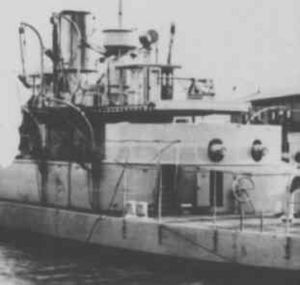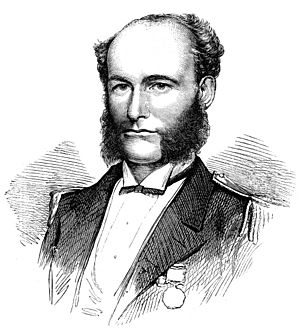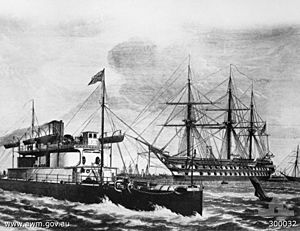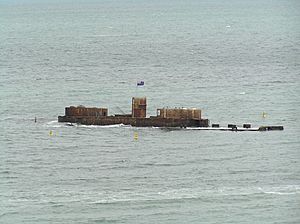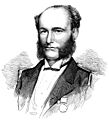HMVS Cerberus facts for kids

Cerberus at Williamstown in 1871
|
|
Quick facts for kids History |
|
|---|---|
| Name | HMVS/HMAS Cerberus |
| Ordered | 1 July 1867 |
| Builder | Palmers Shipbuilding and Iron Company, Jarrow |
| Laid down | 1 September 1867 |
| Launched | 2 December 1868 |
| Completed | August 1870 |
| Renamed | HMAS Platypus II (1 April 1921) |
| Fate | Sunk as breakwater, 2 September 1926 |
| General characteristics | |
| Class and type | Cerberus-class breastwork monitor |
| Displacement | 3,340 long tons (3,390 t) |
| Length | 225 ft (68.6 m) |
| Beam | 45 ft 1 in (13.7 m) |
| Draught | 15 ft 6 in (4.7 m) |
| Installed power | 1,369 ihp (1,021 kW) |
| Propulsion | 2 × shafts, 2 × Maudslay Son & Field steam engines |
| Speed |
|
| Complement |
|
| Armament |
|
| Armour |
|
HMVS Cerberus (Her Majesty's Victorian Ship) was a special type of warship called a breastwork monitor. She served in Australia's navies from 1871 to 1924.
Cerberus was built for the colony of Victoria and arrived in Port Phillip in 1871. She spent her entire career there. When Australia became a federation in 1901, Cerberus joined the Commonwealth Naval Forces. In 1911, she was renamed HMAS Cerberus when the navy became the Royal Australian Navy (RAN).
By World War I, Cerberus's weapons and engines were old and didn't work well. She was used as a guard ship and a place to store ammunition. In 1921, the ship was renamed HMAS Platypus II and became a support ship for the RAN's submarines.
In 1924, the monitor was sold and later sunk to create a breakwater (a barrier to protect a harbor) off Half Moon Bay. The wreck became a popular spot for scuba diving and picnics. There was a major collapse in 1993. People have been working to save the ship because she is one of the last 'monitors' left. She is also the only surviving ship from Australia's early colonial navies.
Contents
What Was the Cerberus Like?
The Cerberus was named after Cerberus, the three-headed guard dog from Greek mythology. She was the first of a new type of warship called a breastwork monitor. These ships had a central raised area (the breastwork) that protected their rotating gun turrets.
The ship was designed by Edward James Reed, a top ship designer for the British Royal Navy. Cerberus had one sister ship, HMS Magdala. Five other similar ships were built for coastal defense around the British Empire. These seven ships were sometimes called the 'Monster class'.
Size and Speed
Cerberus was about 225 feet (68.6 m) long and 45 feet 1 inch (13.7 m) wide. Her draught (how deep she sat in the water) was 15 feet 6 inches (4.7 m). She had a very low freeboard (the part of the hull above the water) of only 4 feet (1.2 m). The breastwork, which was a protected area, rose 7 feet (2.1 m) above the deck.
The ship usually had 12 officers and 84 sailors. In wartime, 40 more people could join the crew. Cerberus could reach a top speed of 9.75 knots (18.06 km/h; 11.22 mph) (about 18 km/h). Her economical speed was 6 knots (11 km/h; 6.9 mph) (about 11 km/h).
Engines and Power
Cerberus was the first British warship to be powered only by steam. She had two steam engines made by Maudslay Son & Field. These engines were powered by five coal-fired boilers. The engines produced 1,369 indicated horsepower (1,021 kW) of power and turned two propellers.
The ship could carry 240 tons of coal. This coal would last for about five days at top speed or ten days at economical speed. Because of her design, Cerberus was not good for long ocean journeys.
Powerful Guns
Her main weapons were four 10-inch guns, placed in two rotating turrets. Each gun weighed 18 long tons (18 t) and fired a 400-pound (180 kg) shell up to 4,000 yards (3,700 m). These guns were muzzle-loaded, meaning they had to be pulled back inside the turret to be reloaded. This process took about three minutes per shot.
The turrets were at the front and back of the ship. Each turret needed a crew of 33 people and could turn 270 degrees. They had to be cranked into position by hand. The turrets were designed by Cowper Phipps Coles.
Strong Armor
Cerberus was heavily armored. Her hull had a thick armored belt from 6 to 8 inches (150 to 200 mm) thick. This was backed by 9 to 11 inches (230 to 280 mm) of strong teak wood. The breastwork, which protected the central part of the ship, had armor from 8 to 9 inches (200 to 230 mm) thick. The gun turrets had 10-inch (250 mm) armor on their front and 9-inch (230 mm) on their sides. The deck was also armored, from 1 to 1.25 inches (25 to 32 mm) thick.
For extra protection, Cerberus could fill special tanks with water. This would make her sink lower in the water, so only her turrets and breastwork were visible. This made her a harder target to hit.
Impact on Ship Design
When Cerberus entered service, she was considered the most powerful warship in the Australasian region. Her design, with no sails and turrets at both ends, was very important. It influenced the design of future battleships, including the famous dreadnoughts of the early 1900s.
Building the Cerberus
In 1866, the government of Victoria ordered Cerberus. They wanted a strong ship to protect Port Philip Bay and the colony from possible attacks.
The ship was built by Palmers Shipbuilding in Jarrow. She was started on 1 August 1867, launched on 2 December 1868, and finished in August 1870. Cerberus cost £117,556 to build. The British Admiralty paid 80% of this cost.
Cerberus in Service
For her journey to Australia, Cerberus was temporarily changed to make her better for ocean travel. Her sides were built up, and she was given temporary masts and sails. She first tried to sail in October 1870 but had to turn back due to a storm.
She tried again on 7 November and made the journey through the Suez Canal. She had to stop often to refuel because she could only carry ten days' worth of coal. In bad weather, her flat bottom made her roll a lot, up to 40 degrees. The crew almost mutinied several times because of the difficult conditions.
Cerberus finally arrived in Melbourne on 9 April 1871. She became the flagship of the Victorian Navy. At first, people didn't think much of her, and she was nicknamed 'Floating Gasometer'.
Events During Her Service
On 5 March 1881, five men from Cerberus died when their boat was destroyed by a mine during training. These were the only deaths on the ship during her active service.
In December 1882, two divers from Cerberus were sent to help find miners trapped in a flooded gold mine. However, they couldn't help because their dive suits didn't fit, and they didn't have enough air hose.
In 1887, the ship was fitted with torpedo netting to protect against torpedo attacks. By the 1890s, Cerberus was mainly used as a storeship. In May 1900, some of the crew had to be quarantined because of a possible case of bubonic plague.
After Australia became a federation in 1901, Cerberus joined the Commonwealth Naval Forces. In 1911, she became HMAS Cerberus when the Royal Australian Navy was formed. By 1909, her engines were too old to move her. During World War I, she served as a guard ship and a place to store ammunition.
In 1921, Cerberus was renamed HMAS Platypus II and used to support submarines. She was towed to Geelong for this new role.
End of Service and Legacy
Cerberus was sold for £409 on 23 April 1924 to a company that would break her up for scrap. After some parts were removed, she was sold again to the Sandringham council for £150. On 26 September 1926, she was sunk at Half Moon Bay to act as a breakwater for a yacht club. Cerberus never left Port Philip Bay during her life, and she never fired her guns in a real battle.
The wreck now lies in about 10 feet (3.0 m) of water, close to shore. It became a popular spot for scuba diving and picnics. Divers could explore inside the ship.
In 1993, a large part of the ship's structure collapsed due to rust. An exclusion zone was placed around the wreck for safety.
In 2001, a group called 'Friends of the Cerberus' was formed to help save the ship. They successfully campaigned for funding to remove the four heavy 18-ton guns from the deck. These guns were placed on the seabed next to the wreck to reduce the weight on the ship.
The 'Friends of the Cerberus' continue to work towards preserving the ship. Cerberus is important because she is one of the last 'monitor' warships in the world. She is also the only surviving ship from Australia's early colonial navies. She is listed on the Australian National Heritage List, showing her importance to Australia's history.
Images for kids



